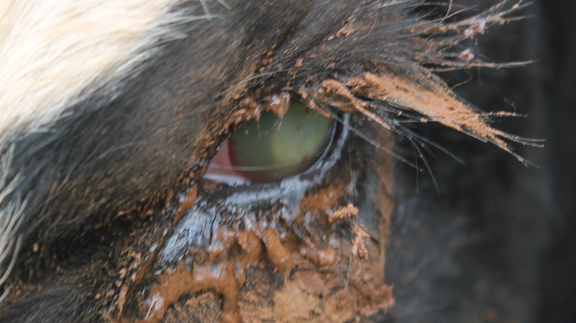Farm & Ranch
Infectious Bovine Keratoconjunctivitis (IBK)—Pink eye

By Jessica Crabtree with Dr. Jered Harlan
Aside from foot rot, infectious bovine keratoconjunctivitis, pink eye, is the next prevalent problem in cattle. Younger cattle seem to be more susceptible because older cattle have built protective antibodies on the eye surface as a result of previous exposure. Grazing cattle to dairy cattle can fall victim to the primary infectious agent of pink eye, a bacterium called Moraxella bovis. Although highly contagious and painful, pink eye is not fatal, but costs producers a great deal of money each year through deceased weight gain, decreased milk supply and treatment costs.
The bacterial disease causes infection and ulceration of the cornea and inflammation of the eye and skin surfaces lining the eye. If not properly treated, pink eye can result in permanent corneal scar and eyeball rupture leading to blindness. Research has shown that Moraxella bovis attaches to the cornea with hair-like protein extensions called pili. Toxins produced by this organism are believed to damage the cornea, leading to a cornea ulcer that looks like a hole or depression in the cornea.
Most common in the summer and fall, pink eye’s initial symptoms include swelling and redness of the conjunctiva, excessive tearing and squinting. Symptoms lead to decreased appetite due to pain and elevated body temperature. Within days a small opaque area will appear in the center of the cornea. By day six the entire cornea will be gray-white to yellow with deep central ulceration of the cornea. Recovery takes three to five weeks. In severe situations, ulceration and corneal rupture with loss of eye contents, cone-shaped bulging of the eye and blindness have occurred.
To read more pick up the April 2015 issue of North Texas Farm & Ranch.
Farm & Ranch
Managing Show Cattle Through The Winter

By Heather Welper
Husband and wife duo, Heather and Calvin Welper, are the Co-Owners and Operators or Two C Livestock, located in Valley View, Texas.
The pair’s operation has a show cattle focus where they raise and sell purebred heifers of all breeds and club calf Hereford steers.
When it comes to show cattle, the Welpers know a thing or two including how to prepare for the cold winter months and the Texas major show season run.
To read more, pick up a copy of the November edition of North Texas Farm & Ranch magazine, available digitally and in print. To subscribe by mail, call 940-872-5922.

Farm & Ranch
Double M Ranch & Rescue

By Hannah Claxton, Editor
As the sun rises each day, so do the dozens of mouths that Meghan McGovern is responsible for getting fed. Rather than the sounds of a rooster crowing, McGovern hears the bellows and bleats of a variety of exotic deer, the chortle of kangaroos, the grunts of water buffaloes, and the chirps of a lemur.
Nestled against the banks of the Red River, the Double M Ranch and Rescue, with its high game fences and deer sprinkling the landscape,s its in stark contrast to the surrounding ranches.
“Having deer is kind of like eating potato chips- you can never actually have just one,” said McGovern with a laugh.
McGovern has several herds to take care of- fallow deer, axis deer, water buffalo, goats, and bison. In smaller numbers, there’s also a few kangaroos, a lemur, a potbelly pig, a pair of zebras, a watusi, and a few horses.
To read more, pick up a copy of the November edition of North Texas Farm & Ranch magazine, available digitally and in print. To subscribe by mail, call 940-872-5922.

Farm & Ranch
Acorn Toxicity

By Barry Whitworth, DVM, MPH
With the prolonged drought, most pastures in Oklahoma end up in poor condition. With the lack of available forage, animals may go in search of alternative foods.
If oak trees are in the pastures, acorns may be a favorite meal for some livestock in the fall. This may result in oak poisoning.
Oak leaves, twigs, buds, and acorns may be toxic to some animals when consumed.
To read more, pick up a copy of the November edition of North Texas Farm & Ranch magazine, available digitally and in print. To subscribe by mail, call 940-872-5922.

-

 Country Lifestyles2 years ago
Country Lifestyles2 years agoScott & Stacey Schumacher: A Growth Mindset
-

 Country Lifestyles8 years ago
Country Lifestyles8 years agoStyle Your Profile – What your style cowboy hat says about you and new trends in 2017
-

 HOME8 years ago
HOME8 years agoGrazing North Texas – Wilman Lovegrass
-

 Outdoor10 years ago
Outdoor10 years agoButtercup or Primrose?
-

 Country Lifestyles5 years ago
Country Lifestyles5 years agoAmber Crawford, Breakaway Roper
-

 Country Lifestyles9 years ago
Country Lifestyles9 years agoJune 2016 Profile – The man behind the mic: Bob Tallman
-

 Equine1 year ago
Equine1 year agoThe Will to Win
-

 Country Lifestyles8 years ago
Country Lifestyles8 years agoDecember 2016 Profile, Rusty Riddle – The Riddle Way




